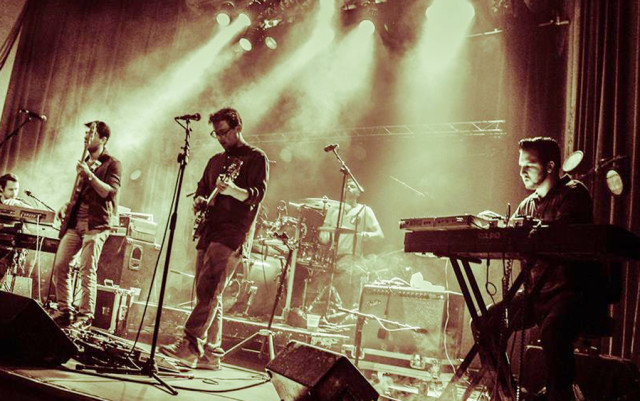
Let’s get this out of the way right off the bat.
We have absolutely no grudge against Montana. Beautiful place — postcard-y mountain ranges, limitless plains of peaceful bison grazing under serene Western skies, crystalline rivers brimming with trout. Yellowstone. Glacier. Kootenai. Big Sky country.
But we want to know how Technicolor Tone Factory, one of Boulder’s best-established jam band franchises and a well-credentialed festival entrant across Colorado, came to be a semi-regular marquee name in places like Whitefish and Phillipsburg. (Bozeman too, but alright, that’s a college town…)
“We work with this agency called Rocky Mountain Artists,” explains Technicolor Tone Factory (TTF) guitarist Cam Canepa, “and through our travels up there, we found that there’s actually quite a music scene up there. Bozeman has got quite a good scene right now. And the same thing with Whitefish, as far away as it is. There’s a little venue up there called the Craggy Range. They love us up there, and we love them.”
There’s a science (and some old-fashioned, industry-smart reconnaissance) to scoping out new markets, but sometimes, as Canepa has found, you just find love in the most unexpected places.
“I’ve found just as random pockets of a scene in places like Lincoln, Nebraska and other places. You just find all these kids who are kind of music starved. … Whitefish is a beautiful area, and there’s actually a decent young population there. We’ve gone up there a few times and done well, and they keep asking us back. “
Being a jam band from Boulder, widely regarded as one of the epicenters of both the groove and acoustic hybrid music subcultures, carries a certain amount of cred out there in the non-Boulder real world. And despite lineup changes over its five-year history, TTF bares its reputation as an emerging livetronica act with commitment and undeniable chops. Their shows display an uncommon fearlessness from dropping into old school prog rock, dance floor funk seductions and spaced-out instrumental excursions.
Still, though, we press Canepa a little bit on the utility-knife paradox: bands that come to pride themselves on being able to pull off a variety of different genres onstage run the risk of being tagged as generalists, rather than masters of their own sound capable of burying their influences below the outfit’s personality. It’s a tricky thing, isn’t it? Once you commit to being a funk band, or an electronica band, or a songwriter’s collective, you gamble the perils of losing a portion of your audience at the expense of excellence in your pursuit of clarity and purpose.
“Yeah, it’s a good question,” Canepa says. “We as a group have had a lineup change, and we’re definitely honing in on a sound more than we have before. The other guitar player left and now we have two keyboardists.
“Our earlier sound, when I first joined TTF [about a year and a half ago], was very eclectic; it was all over the place. Which I’m fine with, because as a guitar player I like to challenge myself and play different styles. But I also see the issue with that, in a set kind of being all over the place — losing interest from some and keeping it with others. In the past few months, we’ve definitely honed in on a more groove-oriented sound. We’re keeping the lyrics and jammy aspect, but individually, we’ve come together and said that we want to sound different from everybody else. We’re debuting some new material next week and the week after that, and we’re really excited because it is different, and we think we’re going to get a good response from it.”
Canepa is keenly aware that the groove scene can inspire, what some might call, laziness. Some of its practitioners simply settle for easy genre-larceny in place of depth and genuine character.
“It’s like getting away from stuff like dropping a random groove into a song where it really doesn’t seem to fit sometimes, which I think bands can do as kind of a show-off thing. ‘Oh, I know how to play a Latin groove in a funk tune.’”
For his part, Canepa cites Trey Anastasio as his earliest important guitar influence, hardly unexpected for a jam-stylist player of his generation. He also points to progists like Tosin Abasi and Guthrie Govan (and decidedly un-progist Pat Metheny) as his current heroes. Canepa remains a reasonably committed Phish disciple, even if he concedes that, at some point, every player needs to find new sounds to deepen their own muse.
“(Anastasio) was the reason I became a guitar player, and I listened to Phish for about 15 years. Until I went through what he himself calls his ‘kill mommy stage,’” Canepa says. Or the stage where a musician stops listening to the music that shaped them.
“And that’s my biggest advice to any guitar player these days. ‘What have you been listening to? Oh, you’ve been listening to Phish and the Dead for seven years?’” he says.
“Move on.”
On the Bill: Technicolor Tone Factory & Rowdy Shadehouse with Big Wave Couch Surfer.
8:30 p.m. Thursday, Jan. 21, The Fox Theatre, 1135 13th St., Boulder, 720-645-2467.














